May proved to be a success. I hit my unofficial monthly quota of books completed (5), including one for my classics club list. Better yet, three of the five reads get the recommended rating.
Sometimes I Lie by Alice Feeney
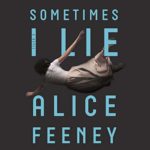
text © 2017
Macmillan Audio, 2018
Narrated by: Stephanie Racine
Here’s how the book begins:
My name is Amber Reynolds. There are three things you should know about me:
I’m in a coma.
My husband doesn’t love me anymore.
Sometimes I lie.
When Amber wakes up, she slowly realizes that she’s in a hospital. Connected to a ventilator by a tube down her throat, she is unable to speak. She’s also apparently unable to move any part of her body and therefore cannot communicate that she’s aware of what’s going on around her.
She also has no memory of whatever happened to put her in this hospital bed, though she has a vague feeling that her husband, Paul, tried to kill her. As Paul and Amber’s sister, Claire, discuss Amber’s situation and what’s happening now, Amber tries to piece things together. There’s something about a car accident, which would explain her current condition, but she just can’t remember. . . .
The story is divided into sections called now—Amber’s attempts to figure things out—then—the story of what happened in the days leadings up to now—and before—entries from a child’s diary ages 10-12 or so). The narrative moves frequently between the various sections. Although the sections are clearly labeled, I had trouble keeping track of just what happened when.
I listened to the audiobook of this one and therefore don’t have a printed edition to consult. I found the book to be way too long, especially the first half or so, when I kept thinking, “Come ON, let’s just get into the story.” I listen to a lot of audiobooks, so I don’t think it was the audio format that caused me to react that way. I’m pretty sure I would have had the same reaction if I had been reading either a printed or ebook version. And the final payoff didn’t seem worth the long build-up.
Overall, I’d rate this novel as mediocre. The plot had potential, but the pacing was off. The book felt more interested in technical bravado than in suspenseful storytelling.
© 2019 by Mary Daniels Brown
Where’d You Go, Bernadette by Maria Semple
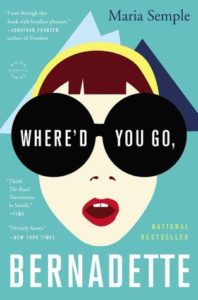
Little, Brown and Company, 2012
ISBN 978-0-316-20426-2
Recommended
I cannot believe this entertaining novel sat on my shelf for more than five years before I finally got around to reading it, prompted by seeing the movie trailer.
Intellectually curious and precociously bright, 15-year-old Bee Branch is heartbroken when her mother, Bernadette Fox, disappears just days before the family plans to leave on a trip to Antarctica. Granted, Bernadette has always been outspoken—sometimes outspokenly cruel—about life in Seattle, but, throughout Bee’s life, that’s just the way her mother has always been.
When Bernadette vanishes, Bee does what she’s always done when faced with a problem to solve: She conducts research and writes a report. Most of the book comprises the documents of the report interlaced with Bee’s commentary. I enjoyed the use of multiple methods of communication (e.g., emails, school memos, magazine article, work reports, letters) collected into narrative sequence. Those documents allow Semple to create well developed characters and to fill in the narrative with information that first-person narrator Bee could not otherwise have known.
The novel’s social satire is humorous but never angry. (Well, Bernadette is sometimes angry, but the book is not.) Lately on Facebook and Instagram I’ve seen a lot of requests for a light, humorous book, and now I have one to recommend.
© 2019 by Mary Daniels Brown
The Eighth Sister by Robert Dugoni
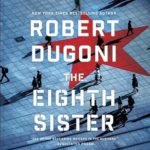
Brilliance Audio, 2019
Narrator: Edoardo Ballerini
Recommended
If Robert Ludlum (The Bourne Identity) and Scott Turow (Presumed Innocent) collaborated on a book, they’d probably end up with something like The Eighth Sister.
Charles Jenkins, the protagonist of Dugoni’s recent novel, age 64, is married to a much younger woman. The couple has a nine-year-old son and another baby on the way. Forty years ago Charlie worked for the CIA. Now he owns a security firm on the verge of bankruptcy. When Charlie’s CIA boss from his last posting shows up and proposes that Charlie undertake an undercover mission to Russia, Charlie reluctantly agrees. After all, he needs the money.
In Part One of The Eighth Sister Dugoni writes an espionage thriller every bit as exciting as Ludlum’s tale of Jason Bourne’s undercover pursuit of the truth about his spy identity. But Dugoni introduces us to Charlie Jenkins and his family before Jenkins sets out for Russia. Although this first part is heavy on plot, as are most spy novels, we’ve also become invested in Charlie Jenkins the character enough to root for him to outrun capture and certain death at the hands of the FSB, the current incarnation of the former KGB.
In Part Two Dugoni gives us a courtroom drama, with accompanying background, as compelling as Rusty Sabich’s investigation in Presumed Innocent. Like Turow, Dugoni has practiced law for many years, so the legal aspects of the novel ring true. Also like Turow, Dugoni is an excellent writer interested in exploring characters as much as in formulating racy plots. The result is an outstanding novel that engages our sense of justice and fairness as much as it precipitates an adrenaline rush.
© 2019 by Mary Daniels Brown
The 7½ Deaths of Evelyn Hardcastle by Stuart Turton
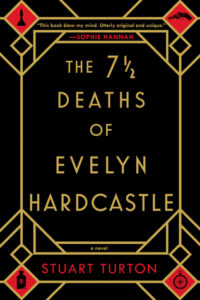
Sourcebooks, 2018
ISBN 978-1-4926-5796-5
(Originally published in the U.K. as The Seven Deaths of Evelyn Hardcastle)
Recommended
At 11:00 pm Evelyn Hardcastle will die—every night until Aiden Bishop can identify the killer and break the cycle. And every time Bishop fails, he wakes up the next morning in the body of a different guest. I loved everything about this mind-bending, genre-blending novel. I came for the puzzle but stayed for the psychology.
The novel combines elements of three genres.
1. The Gothic Thriller
The setting throughout the novel is a decaying mansion reminiscent of the dwelling in “The Fall of the House of Usher” by Edgar Allan Poe.
I reach the edge of the forest, the trees giving way to the grounds of a sprawling Georgian manor house, its redbrick facade entombed in ivy. As far as I can tell, it’s abandoned. The long gravel driveway leading to the front door is covered in weeds, and the rectangular lawns either side of it are marshland, their flowers left to wither in the verge. . . . I have the sense of having stumbled upon something sleeping, that uncertain light [in a second-floor window] the heartbeat of a creature vast and dangerous and still. (p. 5)
This is Blackheath, “a depressing ruin waiting on the mercy of a wrecking ball” (p. 30). The decaying structure contains hidden rooms and passages that allow the guests to sneak around and spy on each other. Bishop sometimes finds esoteric clues to what’s happening, including books with certain words circled or underlines and notes left by others (or by himself in one of his other bodies). A sense of menace, foreboding, doom, and gloom hangs over Blackheath and its guests.
(For more information on Gothic literature, see Gothic Elements in Shirley Jackson’s “We Have Always Lived in the Castle.”)
2. Mystery
Murder is the primary component of mystery, and The 7½ Deaths of Evelyn Hardcastle offers not one, but several murders—or one murder repeated several times. The novel follows the formula of the country-house mystery form perfected by Agatha Christie, which itself is a particular form of the locked-room mystery. The country-house mystery is also called a closed-circle mystery, since none of the characters can leave and no new characters can arrive; the villain must therefore be one of the assembled guests.
3. Science Fiction
When I read that the narrator of the novel can jump from one character to another, I immediately thought of the old TV series Quantum Leap, starring Scott Bakula. Sure enough, Turton mentions in “A Conversation with the Author” at the end of the book that this show was one of the sources for his conception of the story. This feature places the novel squarely within the science fiction genre.
One reason why I like mysteries so much is that I enjoy literary puzzles. So when this novel’s narrator is charged with solving the puzzle of Evelyn Hardcastle’s murder, I eagerly accepted the challenge along with him. I began taking copious notes and keeping track of each undertaking and its results.
But soon thematic content began to overshadow the mere mechanics of puzzle solving. The narrator’s concern over his own identity begins early, almost as soon as he awakens in the forest in the opening scene with no notion of how or why he’s there. Soon afterwards he meets Evelyn Hardcastle for the first time:
“I’m a coward, Miss Hardcastle,” I sigh. “Forty years of memories wiped away and that’s what I find lurking beneath it all. That’s what remains of me.”
. . .
“Well, so what if you are?” she asks. “There are worse things to be. At least you’re not mean-spirited or cruel. And now you get to choose, don’t you? Instead of assembling yourself in the dark like the rest of us—so that you wake up one day with no idea of how you became this person—you can look at the world, at the people around you, and choose the parts of your character you want. You can say, ‘I’ll have that man’s honesty, that woman’s optimist, as if you’re shopping for a suit on Savile Row. . . . You don’t like the man you were Very well. Be somebody else. There’s nothing stopping you, not anymore. As I said, I envy you. The rest of us are stuck with our mistakes.” (p. 40)
In fact, we and the narrator don’t learn that his own name is Aiden Bishop until page 109. The question of identity continues to haunt Aiden Bishop right up until the novel’s end, when all is finally revealed to him.
When Bishop figures out the truth about Evelyn’s murder, that realization is minor compared to what he learns about himself. I didn’t work out the solution to the puzzle because Bishop has information that the reader doesn’t have when he explains who kills Evelyn and why, but by that point in the story the question of identity has become much more important than the puzzle. And it’s the universal human search for identity that makes this novel much more than merely a clever puzzle.
But there is an answer to the puzzle of why the U.K. and U.S. editions have different titles. According to posts by Stuart Turton on Goodreads, the U.K. title was changed for the U.S. edition because of the similarity with The Seven Husbands of Evelyn Hugo.
© 2019 by Mary Daniels Brown
The Iceman Cometh by Eugene O’Neill
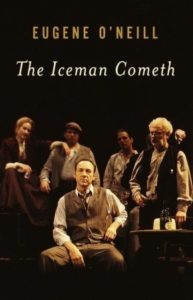
text © 1946
rpt. Vintage Books, 1999
ISBN 0-375-70917-7
I read this for my classics club spin. My review is here.

